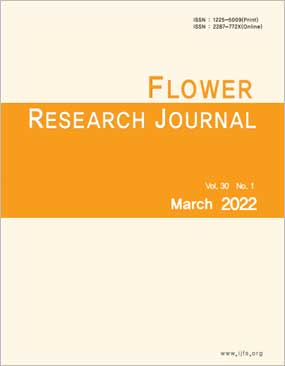서 언
한반도에서는 기온 상승, 강수량, 호우일수의 증가가 나타날 것으로 예측되고 있으며(Kim et al. 2021;Kim and Son 2022), 이같은 변화는 토양침수의 발생빈도를 높일 수 있다(Wu et al. 2024). 특히 도심지는 불투수면적이 넓고 토양용적밀도가 높아 침수에 취약하다(Cameron and Hitchmough 2016;Hirons and Sjöman 2019;Lan et al. 2019). 토양의 침수는 혐기조건을 발생시켜 식물 지하부의 괴사와 양수분의 흡수 를 억제한다(Ashraf 2012;Colmer and Voesenek 2009;Manghwar et al. 2024;Parent et al. 2008). 이는 병충해 감수성 증가와 식물의 고사 및 생육 저해로 이어져 정원의 유지 관리 비용 상승과 환경 및 생태서비스 제공능력 감소를 야기할 수 있다. 따라서 국내에서는 내침수성 정원식물소재의 선발이 중요해질 것으로 예측된다.
내침수성 정원식물소재와 관련된 문헌은 관련분야 종사자의 경험이나 서식지 환경에 기반한 추정에 근거하여 작성된 경우가 많다(Dylewski et al. 2011). 식물의 환경내성은 식물이 기원하는 서식지의 환경과 연관이 있는 것으로 알려져 있으나 (Cameron and Hitchmough 2016;Hirons and Sjöman 2019), 이에 대한 실증적인 근거는 부족한 상황이다. 서식지 환경이 저항성의 선발기준으로 유효한가를 검증할 수 있는 한 가지 방법은 서식지가 상이한 분류군들의 스트레스 반응을 비교 하는 것이다. 골등골나물(Eupatorium lindleyanum DC.), 새등골나물(E. fortunei Turcz.), 좀개미취(Aster maackii Regel), 까실쑥부쟁이(A. ageratoides Turcz.)의 네 자생 숙근초는 동일한 과(국화과, Asteraceae)에 속하고 초형이 유사하여 생육비교가 용이하며, 관상가치가 높아 시중에서 수급 가능하다. 골등 골나물의 경우 숲이나 초지의 습한 장소에, 새등골나물의 경우 도랑이나 강변에, 좀개미취의 경우 고지대의 습한 숲이나 초지 및 냇가 근처에, 까실쑥부쟁이의 경우 산악지역의 숲이나 계곡, 혹은 산비탈의 돌 많은 풀밭에 주로 분포하는 것으로 알려져 있다 (Korea National Arboretum 2001;Missouri Botanical Garden and Harvard University Herbaria 2008;Ohwi 1965). 따라서 골등골나물과 새등골나물, 좀개미취는 높은 정도의 토양수분을 갖춘 서식지를 선호하는 종을, 까실쑥부쟁이는 중간정도의 토양수분을 갖춘 서식지를 선호하는 종을 대표할 수 있다. 본 연구는 토양수분 함량이 생육기간동안 높게 유지될 것으로 여겨지는 서식지에서 기원하는 분류군과 그렇지 않은 분류군의 생육반응을 침수조건 하에서 비교함으로써 서식지 환경이 내침수성 식물소재 선발의 기준으로 유효한가를 확인하고 자 수행되었다.
재료 및 방법
새등골나물과 좀개미취는 2년생 삽목묘, 골등골나물과 까실쑥부쟁이는 2년생 실생묘를 활용하였다. 2024년 07월 26일 기존의 배지를 털어내고 12호 이색 플라스틱 포트(12×10cm)에 용적밀도 0.15~0.25mg/m3의 무토양상토(Baroker, Seoulbio Co., Ltd., Korea)를 배지로 사용하여 이식한 뒤 약 2주간의 활착 후 실험에 사용하였다. 실험은 국립수목원 증식온실에서 2024년 08월 13일부터 2024년 9월 23일까지 약 6주간 진행 되었으며, 실험기간 동안의 주간기온 평균은 8월 27.7°C, 9월 23.5°C, 야간기온의 평균은 8월 23.4°C, 9월 19.7°C, 일최고광도의 평균은 8월 135.7μmol m-2·s-1, 9월 113.1μmol m-2·s-1 로 관측되었다(WatchDog 1000 Series Data Logger, Spectrum Technologies, USA). 처리의 설계는 작물의 내침수성을 다룬 Belford et al.(1980)와 Wu et al.(2018) 등의 연구와 도심녹 지화단에서 나타날 수 있는 침수조건의 양상을 고려하여 진행된 Dylewski et al.(2011) 및 Yuan and Dunnett(2018)의 실험을 참고하였다. 처리는 5일 침수 후 4일 배수와 7일 침수 후 4일 배수를 실험기간동안 반복하는 5일 침수처리와 7일 침수처리 두 가지 유형으로 진행하였으며, 5반복 난괴법으로 각 블록 당 처리 별 1개체씩 배치하였다. 침수처리는 흑색 사각 수련분 (18×15cm)에 개별적으로 포트를 배치하고 용토 표면까지 침지하는 방식으로 이루어졌다. 실험기간 중 2주마다 엽수, 생장점의 수, 초장 등 생장반응과 SPAD와 광계 II의 최대양자효율(Fv/Fm)값 등 광합성반응을 측정하였으며, 실험 종료시에 식물체를 수확하여 생체중과 건물중, 지상부 대비 지하부의 비율(R/S율)을 조사하였다. 수집된 데이터는 SPSS PASW Statistics 18 (Release 18.0.0, IBM Corporation, USA)을 활용하여 분산분석 후 p≤0.05 수준에서 Duncan의 다중검정법으로 검정하였다.
결과 및 고찰
골등골나물과 새등골나물은 처리구 일부 개체에서 주간 위조 현상과 포트 하단부 근부 소실이 관찰되었으나(Fig. 1), 모든 처리구에서 생장반응, 광합성반응, 생체중, 건물중, R/S율에 있어 대조구와 유의한 차이가 나타나지 않아 강한 내침수성을 갖춘 것으로 간주할 수 있었다(Table 1~3). 한편 까실쑥부쟁이의 경우 5일 침수처리구는 처리 4주차, 7일 침수처리구는 처리 2주 차에 고사율이 100%에 달하여 내침수성을 갖추지 못한 것으로 볼 수 있었다(Table 1, 2). 좀개미취의 경우 엽수는 5일과 7일 침수처리구에서 실험 2주차에는 대조구의 44.7% 와 40.2%, 실험 4주차에는 대조구의 22.5% 와 9.1%, 6주차에는 대조구의 19.1% 와 0% 로 각기 유의하게 감소하였으며, 생장점의 수는 5일 침수처리구의 경우 실험 6주차에 대조구의 38.7%로, 7일 침수처리구의 경우 실험 4주차에 대조구의 29.9% 로 유의하게 감소하였다(Table 1). 또한 지상부 생체중 및 건물중과 지하부 생체중의 경우 두 처리구 모두 대조구에 비해 유의하게 감소하였다(Table 3). 그러나 SPAD 값은 모든 처리구에서 대조구와 유의한 차이가 나타나지 않았으며, Fv/Fm 값의 경우 5일 침수처리구는 대조구와 유의한 차이를 보이지 않았다(Table 2). 또한 지하부 건물중은 5일 침수처리구에서 대조구와 유의한 차이가 나타나지 않았으며, R/S율은 두 처리구 모두에서 대조구와 유의 차를 보이지 않았다(Table 3). 엽록소함량, 엽록소형광 등 광합성기구와 연관된 생육반응은 내침수성의 유효한 지표인 것으로 보고된 바 있으며(Lin et al. 2022;Smethurst and Shabala 2003;Yuan and Dunnett 2018), Pang et al.(2004)는 6가지 보리 유전형에 있어 침수스트레스 하에서의 광합성률, 엽록소함량, 엽록소형광 등 생육반응이 침수스트레스 해소 후 생육 회복과 관련되어 있음을 보고한 바 있다. 따라서 좀개미취는 제한적인 내침수성을 지니나, 최소 5일 침수처리와 상응하는 조건까지는 침수조건의 해소 후 생육을 회복할 여지가 있는 것으로 판단되었다.
실험결과, 토양수분함량이 높은 서식지를 선호하는 골등골나물, 새등골나물, 좀개미취는 내침수성을 보인 반면 토양수분 함량이 중간 정도인 서식지에 분포하는 까실쑥부쟁이는 내침수성을 보이지 않아 서식지 환경특성이 내환경성과 연관성을 보임을 확인할 수 있었다. 그러나 토양이 습윤한 서식지에 분포하는 세 분류군 중 좀개미취는 낮은 수준의 내침수성을 나타내었다. 좀개미취의 자생분포범위는 한반도 오대산 이북 지역, 만주, 연해주 등으로 지온이 상대적으로 낮은 고위도 지역이며(Korea National Arboretum 2001;Missouri Botanical Garden and Harvard University Herbaria 2008;Ohwi 1965;Royal Botanic Gardens Kew 2024), 수변에서 발생하는 경우 용존산소량이 높은 유수천변에서 주로 나타난다(Korea National Arboretum 2001). 낮은 지온은 식물 지하부의 산소 요구도를 감소시킴으로써 침수피해를 경감할 수 있는 것으로 알려져 있다(Hirons and Sjöman 2019;Huang 2000). 또한 유수천변에 분포하는 계류연안식물(rheophyte)의 경우 토양수 분함량이 높은 환경에서 기원함에도 지하부의 산소요구량이 높은 경향을 지녀 다수의 분류군이 재배 시 통기성이 양호한 배지를 요함이 보고된 바 있다(Lundquist et al. 2017). 좀개미취의 제한된 내침수성은 이러한 요인에서 기인하는 것으로 보인다. 결론적으로, 서식지 환경특성에 기반한 내환경성 소재의 선발은 유효한 접근 방법으로 간주될 수 있었으나, 자생지의 토양수분 환경에 더해 기후, 지형, 토양수분을 공급하는 수원의 종류 등 여러 요인에 대한 복합적인 고려가 필요한 것으로 판단되었다. 또한 Pang et al.(2004)은 동일한 침수처리 하에서도 모래, 양토, 양분(sheep manure)을 2:1:1의 비율로 혼합하여 제조한 용토에 비해 회색 버티졸 토양에서 더 큰 폭의 생육감소가 나타남을 보고한 바 있다. 본 실험에서는 용적밀도가 낮은 무토양상토가 배지로 사용되었으므로, 추후 보다 다양한 배지를 활용한 실험이 진행될 필요가 있을 것으로 판단된다.
















